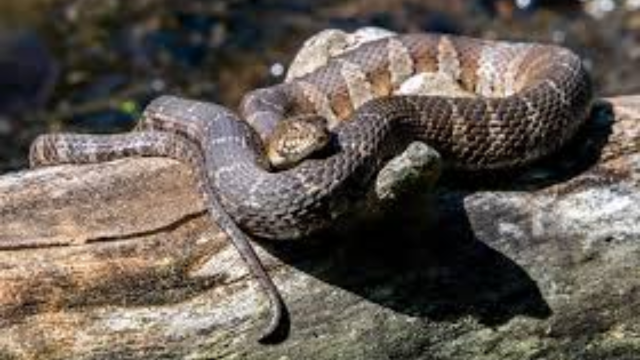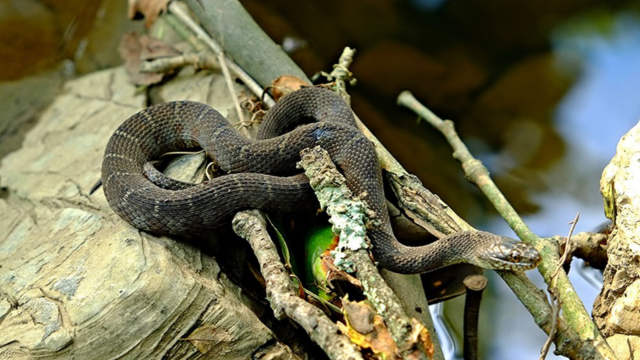There are a great number of amphibians and reptiles that can be found in the unique ecology of New Jersey. Within the state of New Jersey, the vast majority of snakes are harmless and play an important role in the ecosystem.
In spite of this, there are some areas that have a higher population density than others and provide a habitat for poisonous snakes.
In Round Valley Reservoir, for instance, you might come across copperhead snakes that are dangerous, and in Atsion Lake, you might even come across a timber rattlesnake.
However, despite the presence of slithering creatures, you should not let this prevent you from visiting these outdoor spaces because they provide a wide variety of opportunities for leisure activities.
Pond Hopatcong Lake
It is possible for a great number of snake species to thrive in the surrounding wetlands and wooded areas of Lake Hopatcong, which is the largest freshwater reservoir in the state of New Jersey. The northern water snake and the eastern garter snake are two of the most prevalent types of snakes found in this region.
The Northern Water Snake is a non-venomous species that is commonly seen in Lake Hopatcong. In close proximity to the coast, you can find them swimming or lazing on rocks respectively. They can grow to be as long as four feet in length and have a darker banding pattern that is distinctive to them.
The bullhead catfish, minnows, sunfish, and brook trout are the foods that they consume.
The eastern garter snake, which can be clearly recognized by the three bright stripes that run along its dark body, regularly inhabits the grassy sections that are located in close proximity to the lake.
These snakes feed on a wide variety of prey, including toads, frogs, birds, and insects. In the event that they recognise you, they will most likely flee (or slither) away, and they are normally not violent unless they feel threatened.
The reservoir of Manasquan

Activities including as fishing, boating, hiking, and bicycling can be enjoyed at this 770-acre reservoir located in Monmouth County.
The Northern Brown Snake is a harmless, little snake that is native to the region. Its coloration is often tan, gray, or brown, and it is relatively harmless. It is characterized by having dark patches on both sides and broad stripes of a lighter brown color running down its back.
The majority of the food that these snakes consume is earthworms and slugs, although they will also consume snails, salamanders, and beetles with some frequency.
Another kind of snake that does not possess venom and can be found in the vicinity of the reservoir is the eastern worm snake.
This snake protects itself by producing a pungent stench and releasing it. Worm snakes obtained their name from their “wormy” appearance, which consists of brown, gray, or black backs with pink or white bellies. Worm snakes consume earthworms, but their name comes from their appearance.
Do not be concerned if you happen to come upon this young man. In addition to being blind, this small snake does not bite.
Lake of Atitlan
A wide range of ecosystems may be found in Atsion Lake, which is one of the many lakes that are located inside the Wharton State Forest. Hiking along picturesque trails, canoeing or kayaking, swimming, picnicking, fishing, and camping are all activities that can be enjoyed while exploring the historic Batsto Village.
The northern water snake is a common species that thrives in the large number of water sources that are discovered inside the forest. You might catch a glimpse of these amazing animals while they are sunbathing on rocks or hunting fish and amphibians.
They can be recognized by the black bands that run over their bodies, which are gray, tan, buff, or brown in color. Copperheads and cottonmouths are two similar snakes that are commonly confused with these harmless snakes.
Timber rattlesnakes are enormous toads that come in a variety of colors. They have a gray coat with pink striations dispersed down the length of their backs. Their stripes might be pink, black, brown, yellow, or orange. They can also be brown.
Amphibians, lizards, birds, and small rodents are some of the prey that these snakes ingest when they ambush their prey.
Lake of the Assunpink

As part of the Assunpink Wildlife Management, which encompasses a total area of 6,393 acres and consists of farms, hedgerows, forests, and wetlands, this lake is one of three lakes.
It is possible to recognize Eastern hog-nosed snakes by the fact that their bodies are gray, tan, pink, yellow, orange, or red in color, and they have splotches of black or dark brown.
Due to the fact that they love sandy soils, you might come across these snakes in close proximity to a river or lake. The hog-nosed snake is known to consume a wide variety of prey, including lizards, salamanders, small mammals, birds, and frogs. Although they have a weak venom, these snakes are not particularly aggressive and they do not bite very often.
Another type of snake that you can potentially come across is the smooth green snake. The grassy areas are where they make their home. They are small, bright green snakes that are adept at concealing themselves.
There are a variety of non-venomous food sources that this snake consumes, including caterpillars, crickets, moth larvae, spiders, tiny insects, slugs, grasshoppers, ants, snails, and worms.
The reservoir in Round Valley
Although it is the second-deepest lake in New Jersey, the Round Valley Reservoir is the largest reservoir in the state. It spans an area of approximately 2,350 acres and has a depth of approximately 180 feet. Hunterdon County is the location of this location.
The eastern ribbon snake is a quick and thin specie that is commonly observed in close proximity to bodies of water. It has yellow stripes running along its body.
These serpents are active throughout the day and feed on frogs, salamanders, and fish that live in freshwater. Despite the fact that they are not dangerous, eastern ribbon snakes will flee if they perceive that they are in danger.
Copperheads are a type of snake that should be avoided at all costs.
Dark, chestnut-brown or reddish-brown crossbands and reddish-brown heads are the distinguishing characteristics of these nocturnal pit vipers. Copperheads may only devour ten to twelve meals each year, but this number can vary depending on the size of their prey.
Insects, frogs, turtles, lizards, snakes, and mammals are foods that they consume. Protecting yourself from copperheads is the best line of action to take in the event that you come across one. Maintain a safe distance and give it plenty of space.